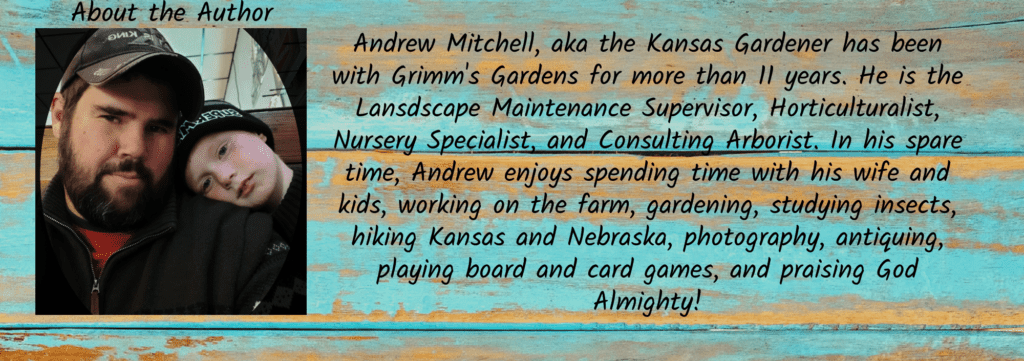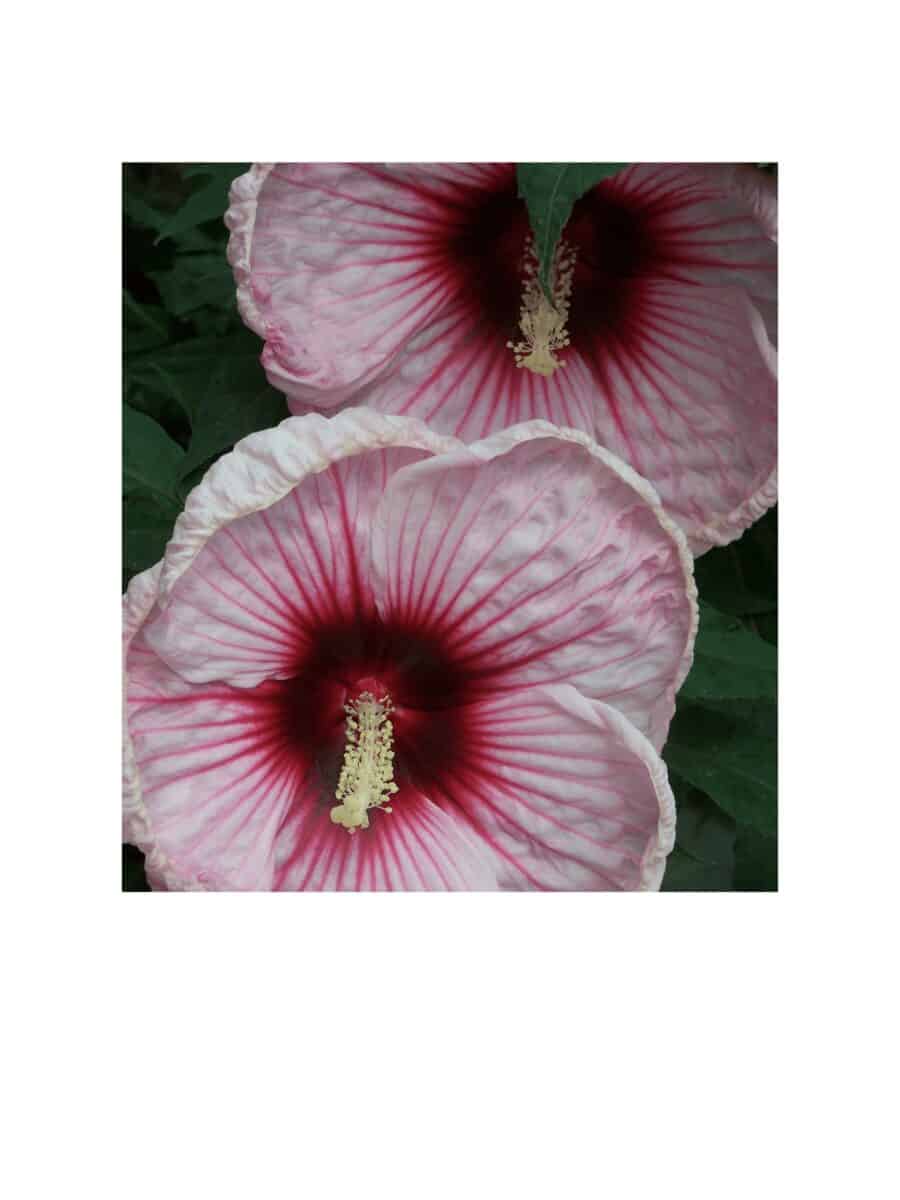Hardy hibiscus love the heat, so when summer hits, it starts exploding in the garden. I follow a lot of gardening groups online, and one of the biggest concerns people have is the slow start of their hardy hibiscus. Is it dead? Why is it not growing yet? It is a yearly thing, especially with new gardeners and homeowners who have not the experience with them.
Besides being a heat loving perennial, hardy hibiscus, with its large flowers, can add a tropical feel to the garden. I really love some of the new cultivars, because their flowers are so spectacular. You can get a hibiscus to fit in nearly every full sun spot of the garden.
Most of the hardy hibiscus you find in nurseries are bred from native hibiscus, which grow east of the Rocky Mountains. There are 30 species of hibiscus native to the continental United States, and several introduced species which are somewhat invasive in the Southeast. However, only a few older cultivars and the native species reseed in the landscape. One of my biggest clients has a bed of pink and white hibiscus which reseeds into the bed, and fills it up with new plants.

Where to Plant and How To Care for Hardy Hibiscus
Before we look at cultivars, it is best to check you garden or landscape and decide where to put it. Many gardeners buy plants at nurseries and have no idea where to put them (I am guilty of this too). But hardy hibiscus can be quite large, and need to have room to fill in.
Hardy hibiscus is best planted in full sun, with at least 6 hours of sun per day. You can put it in a part shade or sun location, as long as it gets those 6 hours of sun. I have a smaller cultivar with pink flowers in part sun, but it does get sun from 10 to 4, and then the trees shade it out the rest of the day. Also, they prefer to be in slightly moist soil, though they are adaptable to drought conditions.

Hardy hibiscus are hardy in mostly in Zones 5 to 9, but there may be some cold hardy selections.
Pests and Problems
When caring for your hibiscus, you need to be aware of the pest problems. Here in the Central Great Plains, Japanese beetles and hibiscus sawfly are the 2 biggest pests. If you are growing hibiscus just for the flowers, and not to eat the petals or calyxes (more on this below), then using a systemic insecticide can prevent both beetles and sawfly. But, if you are an organic gardener like me, you will not want to use chemicals. I do not mind the hibiscus sawfly, as they only eat the leaves, and I can handpick or trap the Japanese beetles.
As for diseases, there none which cause great concern. Powdery mildew, rust, and leaf spots are common, but rarely need treatment.
Annual Maintenance Care
When it comes to pruning back your hardy hibiscus, nothing could be easier. In late fall (October or November), after the leaves of the plant have dropped, simply cut the stalks back to about 2 inches tall. In 2 years, these old stalks will be rotten and can be removed completely. No other maintenance care is needed.
Choosing A Cultivar or Variety
When is comes to picking a cultivar of hardy hibiscus, I like to divide it up between leaf colors. You can pick one with either a green leaf or a maroon/red leaf, and there are many flower colors. The only flower color we do not yet have available is yellow, but breeding programs are working on that.
Green Leaved Varieties
- Cherry Cheesecake – grows 4 to 5 feet tall and wide. It has pink and white petals with a cherry red center. The flowers are 7 to 8 inches across.
- Cranberry Crush – grows 4 feet tall and wide with bright red petals. The flowers are 7 inches across.
- Valentine’s Crush – has 8 inch flowers in deep red with a purple eye or center. The plants grow 4 to 5 feet tall and wide. Hardy in Zones 4 to 9.
- White Disco Belle – has white flowers with a bright red eye and the flowers can be 9 inches across. Plants are more dwarfing than others, growing 2 feet wide by 3 feet tall.
- Rosie Red Disco Belle – has pink flowers with a red eye on 2 foot wide plants that get 3 feet tall. Flowers are 9 inches wide and it is hardy in Zones 4 to 9.
- Luna White – grows 2 to 3 feet tall and wide. It has white flowers with a red eye.
- Luna Rose – grows 2 to 3 feet tall and wide. It has pink flowers with a dark pink eye.
- Cranberry Punch – has fruit punch colored flowers (red-pink) on a short plant, growing 2 to 3 feet tall and wide. It is hardy in Zones 4 to 9.
- Disco Belle Pink – grows 2 to 3 feet tall and wide and has pink flowers with a red eye. It is hardy in Zones 4 to 9.
- Cristi – is a nativar of Swamp rose mallow. It grows 6 feet tall by 4 feet wide and has ruby red flowers. It is hardy in Zones 4 to 9 and is a great plant for native, wet meadow gardens.
- Luna Red – has bright red flowers on 3 foot tall and wide plant. It is hardy in Zones 4 to 9.

Maroon/Bronze Leaved Varieties
- Cherry Choco Latte – has 9 inch blooms on 3 to 4 feet tall and wide plants. The flowers are pink with red veining and a red center. Zones 4 to 9.
- Starry Starry Night – has very dark purple leaves, nearly black, on 3 to 4 foot tall and wide plants. The flowers are pink with red veining and a red eye. Zones 4 to 9.
- Holy Grail – perhaps my favorite of the extremely dark leaved varieties, it has dark red flowers. It grows 5 feet tall and wide and is hardy in Zones 4 yo 9.
- Berry Awesome – has dark pink flowers with a red eye. Plants grow 4 feet tall by 5 feet wide. Zones 4 to 9.
- Royal Gems – has huge flowers, up to 12 inches across, which are pink with a red eye. It grows4 feet tall and wide. Zones 4 to 9.
- Perfect Storm – grows 5 feet tall by 4 feet wide. The flowers are pink with a red eye. Zones 4 to 9.
- Spinderella – has pink and white flowers with a red eye and a slight twist of the petals around the center. Plants grow 4 to 5 feet tall and wide. Zones 4 to 9.
- French Vanilla – has white flowers with a red eye. The plants grow 4 feet tall and wide. Zones 4 to 9.
- Edge of Night – has a very dark maroon leaves. The flowers are dark pink with a red eye. Plants grow 4 feet tall and wide. Zones 4 to 9.
- Dark Mystery – has dark leaves with pink flowers that have a bright red eye. Plants grow 5 to 6 feet tall and wide. Zones 4 to 9.
Companion Plants for Hardy Hibiscus
Okay, so you have some hardy hibiscus now. But what do you plant with them? It can be tricky to put plantings together. However, I like to just try different things together until I find a harmonious whole. Following are some plants that work will with hibiscus and love the heat too.
- Switchgrass ‘Northwind’
- Rudbeckia ‘American Gold Rush’
- Culver’s Root
- Daylilies
- Sedum ‘Autumn Fire’
- Ornamental Onion ‘Serendipity’
- Coreopsis ‘Zagreb’
- Rudbeckia laciniata ‘Goldquelle’
- Prairie blazingstar
Edibility of Hardy Hibiscus
Did you know that the flower petals and calyxes of all hibiscus are edible? It is true. If you find hibiscus blueberry tea in the store, it is made using the flower petals of hibiscus. Click here for a recipe for blueberry hibiscus tea.
Conclusion
Adding hardy hibiscus to the garden not only helps add color during hot weeks of summer, it can add an edible element. Hibiscus grows best in full sun, in hot yet damp locations. Get yours today for some tropical flair!
Happy planting!





We live in Arkansas right in the middle of the state, is this something that can fair the winter here?
Yes, absolutely! Hardy hibiscus is hardy to zone 5. You can check your USDA Hardiness Zone on our website or elsewhere online.